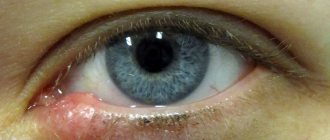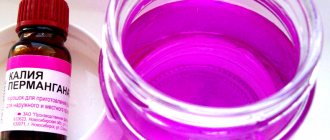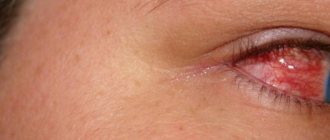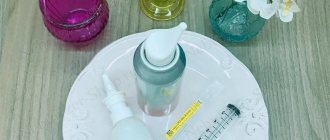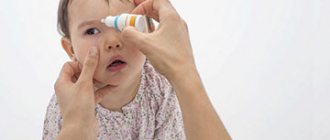In what cases should you not go to the bathhouse or sauna if you are sick?
For your information! Conjunctivitis can be viral, fungal, bacterial, allergic, and several other types associated with specific pathogens or epidemics.
Depending on each specific type, the severity of symptoms can be barely noticeable, moderate or very strong.
But visiting baths and saunas will in no case be useful for the inflammatory process, or rather, its elimination .
Visiting public places, especially such insidious ones, is fraught with unpleasant consequences - from the spread of infection to its addition.
Therefore, it is better to go to the steam room after recovery.
What is worth knowing about the disease?
Conjunctivitis affects the eye area - it can occur in one eye or both, and manifests itself in the form of inflammation of the mucous membrane. Accompanied by unpleasant symptoms (itching, burning, discharge), it can be either contagious or completely harmless to others.
Main symptoms:
- redness of the eye area;
- itching in the eye area that does not stop after scratching;
- discharge;
- copious discharge of fluid from the mucous membrane during sleep.
Depending on the degree of the disease, a person suffering from conjunctivitis may experience different levels of discomfort, but all stages without exception can be treated. As a rule, the disease itself does not go away. Visiting public places with the disease is generally possible, since transmission of the infection (if any) requires close contact.
Most often, restrictions on visiting public places apply to children - at a young age, physical contacts constantly occur, unrestricted and frequent.
Basically, the restrictions regarding patients with conjunctivitis are quite conditional - the patient himself will not want to be exposed to the influence of the environment under the influence of infection, for fear of a deterioration in his health and progression of symptoms.
Causes of conjunctivitis
Acute conjunctivitis occurs solely due to infections that somehow reach the mucous membrane of the eye. The patient infects himself by trying to rub his eye or wipe it without washing his hands first.
The main causative agents of infection are the herpes virus and adenoviruses. Conjunctivitis is also caused by bacterial infections:
- staphylococcus;
- streptococcus;
- meningococcus;
- gonococcus;
- Pseudomonas aeruginosa.
All these organisms take root well in the mucous membrane of the eye, beginning to develop rapidly. Within a few days after infection, a person will begin to feel symptoms in full.
Infections get into the eye due to poor hygiene. In rare cases, when the infection comes from another person, trying to keep your hands clean may not prevent infection. In any case, close contact is required to transmit the virus or bacteria.
How it manifests itself
The symptoms of conjunctivitis are extremely specific and difficult to confuse with anything else. When an infection occurs, the patient experiences severe discomfort, and the quality of his daily life is greatly reduced. The patient loses part of his vision due to constant discharge, experiences itching and even pain.
The main symptoms of conjunctivitis:
- discharge from the eyes (may vary depending on the type of disease - from clear to purulent);
- discomfort in the eye area (itching and burning);
- redness of the eyes (both conjunctiva and eyelids);
- increased lacrimation (due to irritation of the membrane);
- swelling of the eyelids (swelling and “heaviness”).
Since these symptoms are extremely unpleasant and greatly interfere with any activity - rest, work, full social interaction, the patient notices them immediately. In addition to the obvious inconvenience caused by the symptoms, conjunctivitis also greatly changes the appearance for the worse - despite the fact that the effect is temporary, many patients experience great problems with their daily tasks.
What is the danger?
Note! The reality is that visiting saunas and steam rooms is fraught with many more dangers than it seems at first glance:
- A room that is sufficiently warm and humid provides ideal conditions for the existence of pathogenic microorganisms . Their effect on the inflammatory area is detrimental, i.e. local immunity weakens.
- If a patient is diagnosed with an infectious form of the disease , there is a risk that he himself will become a source of infection to other people.
- In case of allergic conjunctivitis, staying in rooms with very high temperatures is contraindicated . Because then the inflammatory process intensifies due to the dilation of the conjunctival vessels. If a person did not know about this and went to the bathhouse, very soon he will notice that the symptoms of the disease have become brighter, even if he is almost cured . Itching, pain and swelling will reappear.
- Hypertensive patients are contraindicated from visiting baths , especially if conjunctivitis has developed. Staying in a stuffy, damp place can result in subconjunctival hemorrhage , which occurs due to pressure surges.
Keep in mind! Inflammation may increase due to the fact that a person’s immune system is weakened.
The disease is transmitted by airborne droplets and household contact, so using other people's towels, slippers and hygiene products is strictly prohibited.
How to use chamomile for conjunctivitis
Chamomile has pronounced anti-inflammatory and antiseptic properties; decoctions and infusions of chamomile flowers soothe pain, relieve inflammation and reduce redness. The use of chamomile at the first signs of inflammation helps to quickly get rid of bacterial or traumatic conjunctivitis.
2. Compress with chamomile – 1 tbsp of dried chamomile flowers, pour 1 tbsp of boiling water, boil in a water bath for 10-15 minutes, let it brew for 30-40 minutes, strain, cool slightly and use for making compresses. To do this, moisten a cotton pad or swab in a warm broth and apply a compress to the eyelids for 15-20 minutes.
Is it possible to wash your hair and take a bath and shower if you are sick?
If you are sick, you can wash your hair and take a bath and shower only if the body temperature is not elevated (sometimes this happens with conjunctivitis), but we must not forget about the safety rules:
- for washing, it is allowed to wash only with boiled water of moderate (not hot!) temperature;
- It is not permissible to get shampoo or rinse into the eyes ;
- for hair you need to use a separate clean towel , which should then be washed immediately.
Reference! An exception is the allergic form of conjunctivitis of unknown nature, because the allergen may be the chemicals contained in the shampoo.
Conjunctivitis can last for several weeks, so you certainly shouldn’t neglect personal hygiene during this time.
Is it possible to bathe a child with conjunctivitis without harm?
11.12.2018
There is an opinion that if you have some illnesses or colds you should not wash. Therefore, it is not entirely clear whether it is possible to bathe or shower a child with conjunctivitis. After all, neglecting the rules of hygiene helps pathogenic microbes grow and multiply on the skin.
How to bathe a baby
Conjunctivitis is an inflammation of the conjunctiva, the membrane lining the eyelid and part of the eyeball. It is most often caused by bacteria, viruses or an allergic reaction. Treatment of conjunctivitis places restrictions on habitual activities such as bathing.
If you follow some rules, you can safely bathe a child with conjunctivitis:
- While swimming, you should not wash your face and eyes, or pour water into your face. The nose, cheeks and chin are wiped with a damp cloth after bathing.
- If you have conjunctivitis, blindfolding is prohibited.
- If water gets on your face, blot it with a separate clean towel rather than drying it.
The child can be washed in the shower or gently bathed in the bath, leaving the face dry. For a baby who does not yet know how to sit or stand confidently, an anatomical bathtub is suitable.
When bathing, you can wash your child with special baby soap, gels, foams, which are sold in children's stores. The main thing is to make sure that they do not get into your eyes.
For skin problems, special pharmacy baby care products can help. Before bathing your child in a decoction of herbs such as chamomile and sage for the first time, it is better to consult a doctor, especially if the child is very young.
After evening bathing, the eyes are cleaned - rinsing and instilling drops in accordance with the recommendations of the ophthalmologist. Everything should be done only with clean hands; First one eye is treated, then the other, a separate cotton pad is used for each eye.
First, with a cotton pad soaked in warm boiled water, the discharge, crusts from the eyelids and eyelashes are carefully removed, and then the drops are instilled. Excess moisture is blotted with a clean, dry cotton pad or towel. This is a standard eye care regimen for conjunctivitis. At the appointment, the ophthalmologist explains in detail to parents what to do in each specific case.
Is it possible to wash?
Washing is a mandatory procedure , especially with conjunctivitis.
It is worth noting! The disease is characterized by the accumulation of purulent discharge on the mucous membrane of the eyelids, so for convenience and hygiene you need to get rid of them.
If you have conjunctivitis, you can wash your face only in boiled water..
The use of any care products (soap, lotion, milk) is not allowed , as well as care products after washing (cream, mask).
The eyes need to be rinsed very carefully, using saline solution : a few drops are dropped into the inner corner of the eye and gently rinsed from the temples to the nose.
If purulent crusts and accumulations cannot be eliminated, you can use a cotton swab dipped in saline solution and gently walk it along the edge of the eyelids.
After washing, you need to carefully wipe your face with blotting movements with a clean personal towel made of natural fabrics .
Important! In some cases, the doctor can give individual recommendations that will help a person survive the disease easier and cure it faster.
Is it possible to bathe a child with conjunctivitis: bathing rules
Home › Conjunctivitis ›
- 1 Bathing for conjunctivitis
- 2 Bathing rules
- 3 Prevention
Conjunctivitis is an inflammation of the mucous membrane of the eyeball. The main cause of the development of the disease is infection, which is transmitted by dirty hands, direct contact with a sick person, smoke, dust, and chemicals.
Both adults and children are at risk of developing the disease. When the first signs of the disease develop, you should consult a specialist.
Important! Ineffective and untimely treatment of childhood conjunctivitis can cause serious consequences and dysfunction of the visual organs.
During the treatment of the disease, it is necessary to strictly observe the rules of hygiene. The question becomes relevant: is it possible to bathe a child with conjunctivitis?
Swimming with conjunctivitis
Caring for a small child involves following the rules of personal hygiene. With the development of childhood conjunctivitis, many parents are concerned about the question: is it possible to bathe a child with conjunctivitis? Experts recommend performing water manipulations taking into account the baby’s condition and the complexity of the disease.
You should not categorically refuse water manipulations. Bathing is the main way to remove infectious bacteria, dirt, and dust from the surface of the skin.
Infectious conjunctivitis is accompanied by high body temperature and purulent discharge from the eyes. It is recommended to refrain from swimming until the disease reaches a milder stage.
The disease can develop on the basis of a cold or viral disease. With this form of the disease, you should not resort to bathing until the child’s condition returns to normal.
Important! To cleanse a child’s skin, it is recommended to use a soft towel and unscented wet wipes.
During the treatment process, you must refrain from using children's cosmetics for bathing: shampoo, gel, soap. They contain various chemical components, flavors, and fragrances that have an aggressive effect on the baby’s delicate skin.
If the product gets on the mucous membranes, an allergic reaction may occur, the inflammatory process may intensify, and resume. It is necessary to ensure that water does not get into the baby’s eyes, and the child does not rub his eyeballs with his hands during the bathing process.
The main signs of conjunctivitis in the eyes
After taking water procedures, you need to carefully pat your baby dry with a soft towel. Do not rub, press on the skin, or use cosmetics on the skin after swimming.
If there is no temperature for swimming, you can use herbal infusions that are added to the water. For bathing children with illness, it is recommended to use chamomile and string. They are characterized by antiseptic, antibacterial characteristics.
The medicinal plant must be brewed in a separate container, infused, then poured into water when bathing. Water procedures are recommended to be carried out in the evening.
Important! Herbal baths have a calming effect on the baby and speed up the healing process.
For conjunctivitis, you can add a little potassium permanganate to the bathing water. It prevents further spread of infection.
Bathing rules
The answer to the question whether it is possible to bathe a child with conjunctivitis depends on the stage of the disease and the condition of the baby. If there is no temperature in the process of taking water procedures, you must follow the recommendations of a specialist.
- Clean the mucous membrane of the eyeballs from purulent discharge. To carry out the manipulation, cotton-gauze discs and balls are used. They need to be soaked in a solution of furatsilin and chamomile. You need to treat the eyeballs with careful, light movements from the inner to the outer corner of the eye.
- During the bathing process, it is necessary to protect the child from getting water on the surface of the mucous membrane of the organs of vision. The baby should be washed while standing, in the shower no higher than the shoulders, you can use special accessories for bathing. Particular attention should be paid to the groin area and armpits, where bacteria can accumulate. You can use swimming goggles to wash your hair.
- After taking a bath, it is not recommended to rub your skin or eyes with a towel, or apply cosmetics: cream, milk, lotion. Dry the skin with a soft towel.
- A decoction of chamomile, string, and a solution of manganese can speed up the healing process. They should be added when bathing. Water procedures with herbal infusions are recommended before daytime or nighttime rest.
- If you have conjunctivitis, drafts should be avoided. Therefore, after bathing, there is no need to take the child out of the bathroom until he is completely dry and dressed.
- After taking a shower, you should let your baby rest. It needs to be placed under a blanket for half an hour. If the air temperature in the house is below 18° C, you need to put warm socks on your baby.
- Medications for the treatment of conjunctivitis should be used 30 minutes after bathing. Warm water can enhance the effect of medications.
Important! If the child is not feeling well, you should avoid bathing until the baby’s condition stabilizes.
Prevention
During the treatment of conjunctivitis, precautions should be taken to prevent re-development of inflammation.
- Limit the child’s contact with a sick person, make sure that he does not touch the mucous membranes with dirty hands, toys, or household items.
- Refuse to attend children's educational institutions until complete recovery.
- During the treatment period, it is not recommended to visit baths, saunas, or swimming pools.
- To carry out inhalation for colds, special devices should be used. There is no need to use open containers with herbal infusions for inhalation. Hot water vapor helps to activate the inflammatory process.
- Before undergoing routine vaccination, you should consult your doctor.
When the first symptoms of conjunctivitis appear, you should consult an ophthalmologist. Untimely therapy or self-medication can lead to the development of undesirable consequences and deterioration of visual acuity.
Conjunctivitis in a child: hygiene and is it possible to swim with eye inflammation Link to main publication
Styes on the eyelid: to heat or not to heat?
Conjunctivitis is a process of inflammation of the conjunctiva of the eyeball. In most cases, the disease causes inflammation of the eyelids. Acute conjunctivitis manifests itself suddenly and is active. With this disease, the intraocular vessels dilate, and there are cases when they burst. The eyeballs become very red, until there are no white marks at all. The eyelids swell and discharge begins to flow from the eyes.
Register Login. Mail replies.
The doctor is a woman, about 50 years old, pleasant. We entered the office with a swollen eye with pus, while we were driving we were all stuck together. The doctor immediately dropped drops, listened to me, looked at my eyes, said I don’t see any obvious signs of dacryocystitis, pus doesn’t come out of the lacrimal sac, everything is fine with it, but when you move the lower eyelid, the conjunctiva is all inflamed. I’m very ashamed - it turns out I didn’t put the drops on my son correctly in the eyes, plus the doctor said that a runny nose complicates the whole matter. Girls, they have no more strength. The child’s conjunctivitis is already in the 3rd round! The first time I was treated with Tobrex. A couple of days later there was a relapse. Then Floxal.
How to treat conjunctivitis at home
Conjunctivitis is an inflammation of the eye caused by bacteria, viruses or allergens entering the mucous membrane. Conjunctivitis can be bacterial, purulent, viral, allergic or chronic.
In each case, the inflammatory process is provoked by different groups of pathogenic organisms. The eye tries to fight inflammation and actively produces tears. Therefore, tearing during conjunctivitis is one of the main symptoms. In fact, in most cases it is simply a reaction to an inflammatory process. Conjunctivitis is considered a disease of dirty hands.
People often get this disease after contact with a sick person, when they rub their eyes with dirty hands. Bacterial conjunctivitis occurs due to the ingestion of bacteria such as gonococcus, staphylococcus, and Pseudomonas aeruginosa. Viral conjunctivitis develops as a result of herpes viruses, fungi, and chlamydia entering the body. Allergic conjunctivitis can be acquired by airborne droplets due to inhalation of allergens.
When a virus, bacteria or other harmful microorganism enters the human body, it can develop there or be completely suppressed. It depends on the person's immunity. A strong and strong immune system is able to resist, but a weak one cannot resist the enemy.
Hygiene is also very important. If you get conjunctivitis, you need to follow some rules. Firstly, personal hygiene products must be strictly individual. This is especially true for those things that come into contact with your eyes - towels, contact lenses, cosmetics.
A few words about contact lenses. If you get conjunctivitis, your lenses need to be thrown away - they cannot be cured of the infection. It is better to use glasses during your illness, and after complete recovery, buy a new pair of lenses. This is the only way to protect your eyes from re-infection. If you have conjunctivitis, you should not rub your eyes, especially with dirty hands.
Use sterile wet wipes for this. During illness, you need to change your pillowcase and towel more often, wash your face more often, using only clean water. When processing, it is important to wash the pipette used for instillation each time.
If you don’t do this, you will re-infect the mucous membrane with microbes each time. At the initial stage of the disease, when you have not yet reached the doctor, but you need to alleviate the symptoms here and now, you can use a solution of furatsilin. A sterile furatsilin solution can be purchased at a pharmacy or prepared independently. To do this, three tablets of furatsilin need to be dissolved in a glass of clean water.
After this, you need to strain the solution through a fine strainer or gauze so that pieces of undissolved drug do not get on the mucous membrane. Furacilin copes well with any eye inflammation. Both eyes need to be treated. When treating conjunctivitis, medications work successfully in combination with traditional medicine recipes.
Drops, lotions and rinses based on medicinal herbs are often not inferior in effectiveness to pharmaceutical drugs. So, how to get rid of conjunctivitis using folk remedies? Conjunctivitis is an unpleasant and contagious disease that often affects children in schools and kindergartens.
Teach your child basic hygiene rules - use napkins, do not put dirty hands in your eyes. This will help protect your baby from conjunctivitis and other diseases. Follow the rules of personal hygiene and don’t get sick! Calorie calculator. Our online calorie calculator will calculate the calories, proteins, fats and carbohydrates of your most favorite dishes and products. Count calories. Moon calendar.
The lunar calendar for the year will reveal to you its secrets of success, wealth, good luck in love. Calculate lunar day. Popular articles. Home Useful tips Medicine and health. Contents of the article 1 Symptoms of conjunctivitis 2 Causes of conjunctivitis 3 Hygiene for conjunctivitis 4 How to treat conjunctivitis 5 Folk remedies for the treatment of conjunctivitis 6 Video: how to treat conjunctivitis in a child.
There is no rating yet. Dangerous and harmful foods for diabetes How is tubal obstruction treated? Venous network on the legs: is it possible to get rid of it? Foods that should never be eaten if you have thrush Foods that you should never eat if you have conjunctivitis Foods that you should never eat if you have hiccups Foods that you should never eat if you have mastitis Foods that you should never eat if you have dysentery .
No comments yet! We are working to fix this!
Treatment of conjunctivitis using traditional methods
In the treatment of this disease, there are a number of folk methods that serve as an auxiliary method on the path to recovery. Among them, the most popular are drops, compresses and lotions, as well as eye wash solutions.
- Gadgets:
- Grind the root of medicinal marshmallow (3 tablespoons), pour 1 glass of cooled boiling water, leave for 8 hours.
- Pour boiling water over the marshmallow flowers and leaves and let sit for half an hour.
- Pour 2 teaspoons of rose hips with 1 cup of boiling water and continue cooking over low heat for another 5 minutes, leaving to steep for 30 minutes. Such lotions are made for purulent compartments.
- Blue cornflower (flowers) 2 teaspoons must be poured with 1 glass of boiling water, left for 2 hours.
- Bird cherry flowers pour 1 teaspoon into 1 glass of cooled boiled water and leave for at least 8 hours. Such compresses perfectly fight inflammation of the eyes.
- Pour boiling water over pharmaceutical chamomile 1:20 and leave for about an hour.
- Pour 1 tablespoon of celandine herb with boiled water (1 glass) and continue cooking over low heat for another 5 minutes, let it brew, strain and add honey (1 teaspoon), stir thoroughly and do these procedures when your eyes really hurt.
- Drops:
- We dilute honey with water, the temperature of which does not exceed 45 degrees (in hotter water, honey will lose all its beneficial properties) in a ratio of 1:2.
- Home treatments:
- take the juices of carrots, parsley, celery and lettuce, mix in a ratio of 4:1:1:1, drink half a glass before meals 3 times a day
- You can also prepare a mixture of carrot and parsley juices 3:1, drink also 3 times a day
- shredded fresh potatoes are adjusted to the eyes
- add egg white to the potato pulp and apply to the sore eye
Conjunctivitis is an infectious disease, so it is necessary to isolate the patient, whether a child or an adult, from others to prevent the spread of the disease. To prevent this disease, following basic rules of personal hygiene will help: wash your hands after walking and before eating, and do regular wet cleaning in the house.
Main symptoms
It is not difficult to determine conjunctivitis in a child. It is characterized by very specific symptoms. If we talk about children under three years of age, they usually exhibit the following signs of conjunctivitis.
- Yellow lumps are noticeable on the eyelids and eyelashes - dried clots of purulent discharge.
- Constant or frequent tearing.
- Unpleasant or even painful sensations in the eyes when rays of light hit them.
- Redness and swelling of the mucous membranes of the eyes.
- The eyelids are also swollen.
- The temperature rises, general weakness is expressed, and chills may appear.
- The child becomes capricious and cries often.
- Deterioration or loss of appetite.
- Sleep disorder.
An older child may also experience a feeling of sand in the eyes, blurred vision, burning, and itching. If conjunctivitis appears against the background of another disease, then its characteristic symptoms are also noted.
